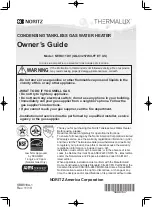
Innovation Water Heaters
– Edge [i] Controller
Venting and Combustion Air Design Guide
TAG-0090_A
•
GF-5056
•
2/20/2020
Technical Support
•
(800) 526-0288
•
Mon-Fri, 8 am - 5 pm EST Page 21 of 39
3.2.
Installation REQUIREMENTS for Venting Through a Wall
The minimum distances from adjacent public walkways, adjacent buildings, operable windows
and building openings shall not be less that those values specified in the National Fuel Gas
Code, ANSI Z223.1 and/or CAN/CSA B149, Installation Codes.
Minimum clearance of 4 feet (1.2 m) horizontally from, and in no case above or below, unless
a 4-foot (1.22 m) horizontal distances is maintained, from electric meters, gas meters, regulators
and relief equipment.
Refer to the notes below and Figure 9, when determining the location of the vent outlet.
a. At least 12 inches (30.5 cm) above finished grade, or at least 12 inches (305 mm) above
the normally expected snow accumulation level in geographical areas where snow
accumulates. With a vent termination clearance of at least 4 feet (1.2 m) from any air
openings into a building.
In Massachusetts
, when side-wall venting is used, the vent termination must be located
a minimum of 4 feet above grade.
For detailed information pertaining to side-wall venting within the Commonwealth of
Massachusetts, see pages 11 and 12 in GF-128 (Innovation).
b. At least 3 feet (0.9 m) above any forced air inlet located within 10 feet (3.1 m).
c. At least 4 feet (1.2 m) horizontally from electric meters, gas meters, regulators and relief
equipment.
d. Do not terminate vent over public walkways or over an area where condensate or vapor
could create a nuisance or hazard or could be detrimental to the operation of regulators,
relief valves, or other equipment.
e. Do not locate the vent termination too close to shrubbery as flue products may stunt
growth or kill them.
f. Some building materials may be affected by flue products expelled near unprotected
surfaces. Sealing or shielding of exposed surfaces with a corrosion resistant material
(such as aluminum sheet) may be required to prevent staining or deterioration.
g. See the US or Canadian Codes listed in Section 1.2, above, for additional information on
termination location.
















































